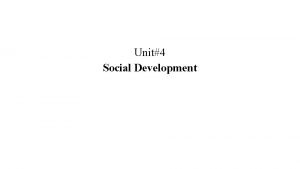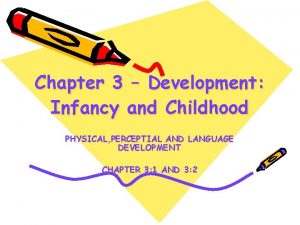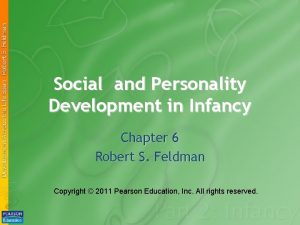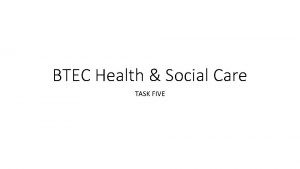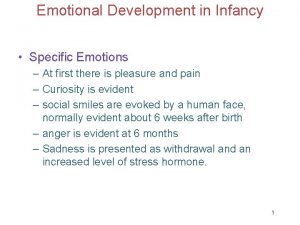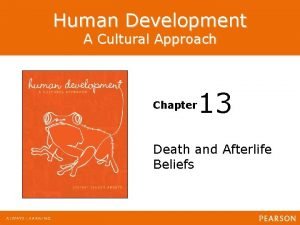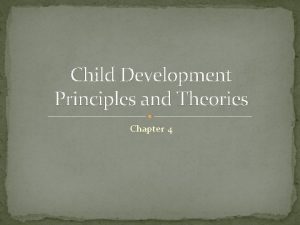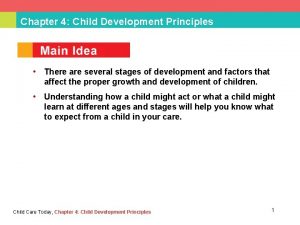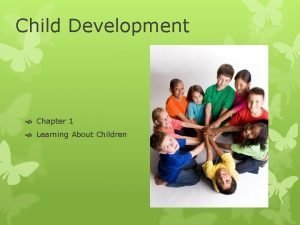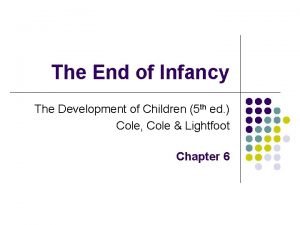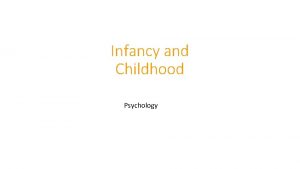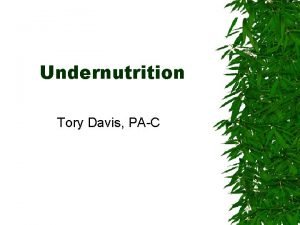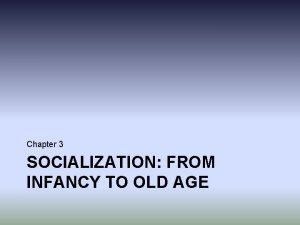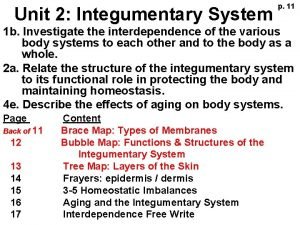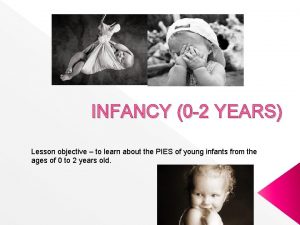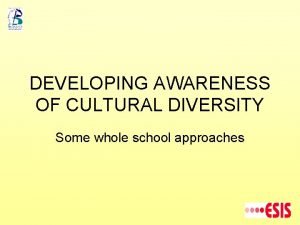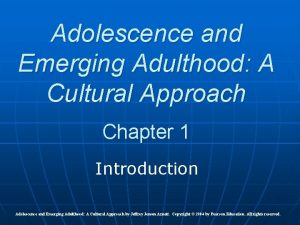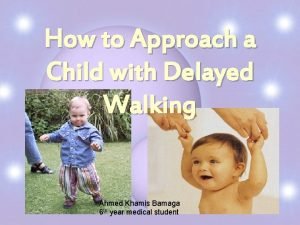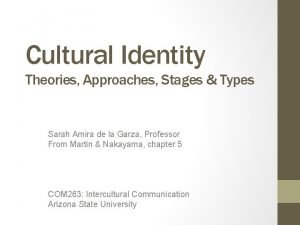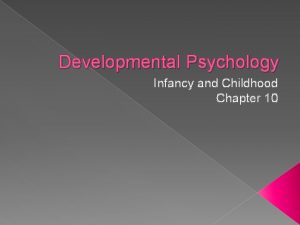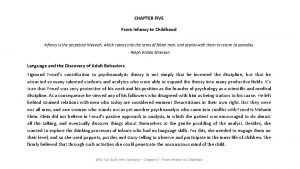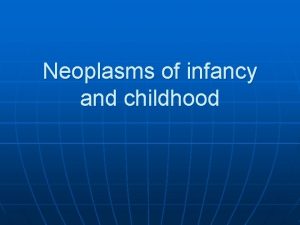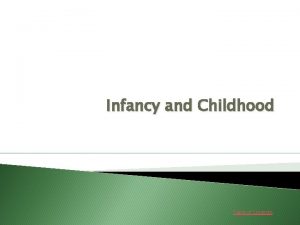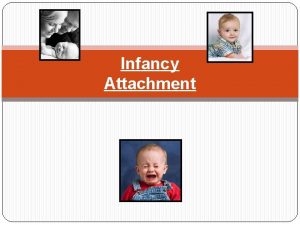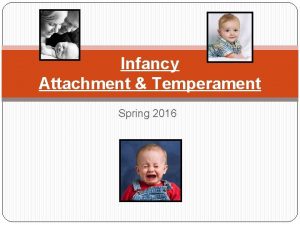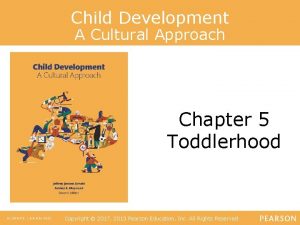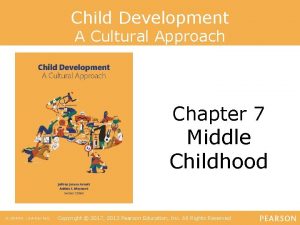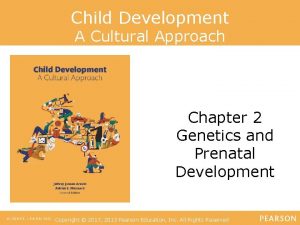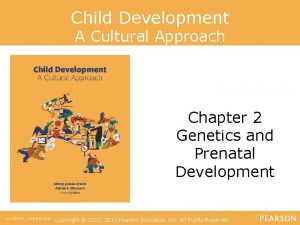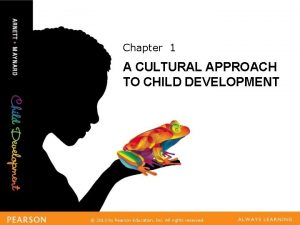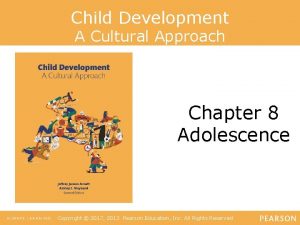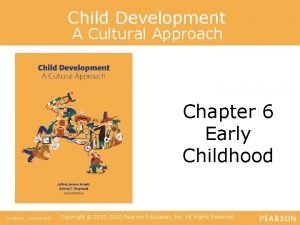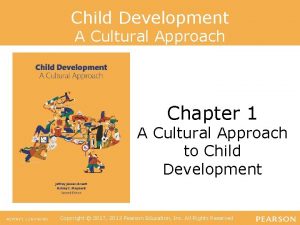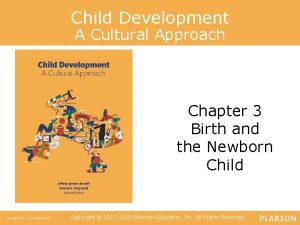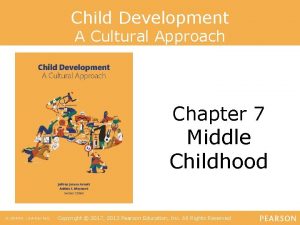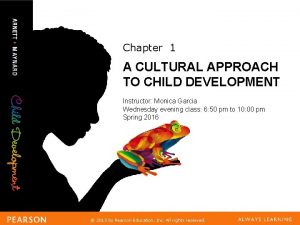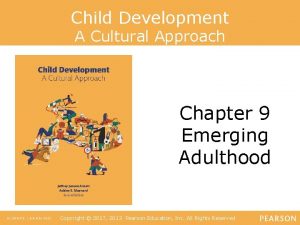Child Development A Cultural Approach Chapter 4 Infancy






















































- Slides: 54

Child Development A Cultural Approach Chapter 4 Infancy Copyright © 2017, 2013 Pearson Education, Inc. All Rights Reserved

Learning Objectives (1 of 5) 4. 1 Describe how the infant’s body changes in the first year, and explain the two basic principles of physical growth. 4. 2 Identify the different parts of the brain and describe how the brain changes in the first few years of life. 4. 3 Describe how infant sleep changes in the course of the first year and evaluate risk factors for SIDS, including the research evidence regarding cosleeping. Copyright © 2017, 2013 Pearson Education, Inc. All Rights Reserved

Learning Objectives (2 of 5) 4. 4 Describe how infants’ nutritional needs change during the first year of life and identify the reasons for and consequences of malnutrition in infancy. 4. 5 List the major causes and preventive methods of infant mortality and describe some cultural approaches to protecting infants. 4. 6 Describe the major changes during infancy in gross and fine motor development. 4. 7 Describe how infants’ sensory abilities develop in the first year. Copyright © 2017, 2013 Pearson Education, Inc. All Rights Reserved

Learning Objectives (3 of 5) 4. 8 Describe the first four sensorimotor substages of Piaget’s theory. 4. 9 Describe how the elements of the informationprocessing model of cognitive functioning change in infancy. 4. 10 Describe the major scales used in measuring infant development and explain how habituation assessments are used to predict later intelligence. 4. 11 Evaluate the claim that educational media enhance infants’ cognitive development. Copyright © 2017, 2013 Pearson Education, Inc. All Rights Reserved

Learning Objectives (4 of 5) 4. 12 Describe the course of language development over the first year of life. 4. 13 Describe how cultures vary in their stimulation of language development. 4. 14 Define infant temperament and its main dimensions. 4. 15 Explain how the idea of goodness-of-fit pertains to temperament on both a family level and a cultural level. Copyright © 2017, 2013 Pearson Education, Inc. All Rights Reserved

Learning Objectives (5 of 5) 4. 16 Identify the primary emotions, and describe how they develop during infancy. 4. 17 Describe infants’ emotional perceptions and how their emotions become increasingly social over the first year. 4. 18 List the main features of infants’ social worlds across cultures. Copyright © 2017, 2013 Pearson Education, Inc. All Rights Reserved

Physical Development Copyright © 2017, 2013 Pearson Education, Inc. All Rights Reserved

Growth Patterns • Infants grow at a faster rate during their first year than at any other time • Weight doubles in first 5 months and triples by end of first year • Height is more uneven in growth than weight • Growth follows two patterns – Cephalocaudal principle – Proximodistal Copyright © 2017, 2013 Pearson Education, Inc. All Rights Reserved

Figure 4. 1 The Cephalocaudal Principle of Body Growth begins with the head and continues downward to the rest of the body Copyright © 2017, 2013 Pearson Education, Inc. All Rights Reserved

Brain Development • At birth, brain is one-quarter the size of adult’s brain • By age 2 it will reach 70 percent • Growth in brain due to – Exuberance – dendritic connections multiply – Myelination – axons become encased in a myelin sheath • Efficiency increases due to synaptic pruning Copyright © 2017, 2013 Pearson Education, Inc. All Rights Reserved

Figure 4. 2 The Synapse Copyright © 2017, 2013 Pearson Education, Inc. All Rights Reserved

Brain Specialization • Brain divided into three major regions – Hindbrain – Midbrain • Both structures mature early and perform basic biological functions – Forebrain § Limbic system – hypothalamus, hippocampus § Cerebral cortex – lobes Copyright © 2017, 2013 Pearson Education, Inc. All Rights Reserved

Figure 4. 3 Lobes of the Brain What are the distinct functions of each lobe? Copyright © 2017, 2013 Pearson Education, Inc. All Rights Reserved

The Plasticity of the Infant Brain • Plasticity important for the infant’s brain development • Adaptable to overcome damage • Two basic functions – Experience-expectant brain functions – Experience-dependent brain functions • Environmental deprivation can have permanent effects • Example seen in Romanian adoptions Copyright © 2017, 2013 Pearson Education, Inc. All Rights Reserved

Figure 4. 4 Romanian Adoptees’ Cognitive Abilities, by Age of Adoption The later the age of adoption, the lower their cognitive abilities. Copyright © 2017, 2013 Pearson Education, Inc. All Rights Reserved

Sleep Changes • Neonates sleep 16 to 17 hours • At 3 to 4 months sleep 6 to 7 hours at night • At 6 months cultural patterns influence sleep patterns – American: 14 hours – Kipsigis: 12 hours – Dutch: 16 hours Copyright © 2017, 2013 Pearson Education, Inc. All Rights Reserved

Sudden Infant Death Syndrome ( 1 of 2) • Infants between 2 to 4 months of age have highest risk for Sudden Infant Death Syndrome (SIDS) – Leading cause of death for infants 1 to 12 months in developed countries – Ethnic variations • Asian descent less likely while higher rates for African Americans and Native Americans – Poorer prenatal care could be a factor Copyright © 2017, 2013 Pearson Education, Inc. All Rights Reserved

Sudden Infant Death Syndrome (2 of 2) • No clear cause but there are risk factors – Sleeping on stomach instead of back – Low birth weight and APGAR score – Smoking – Soft bedding • Campaign to reduce SIDS includes a “BACK to Sleep” campaign • Campaign has caused reduction of SIDS worldwide Copyright © 2017, 2013 Pearson Education, Inc. All Rights Reserved

Figure 4. 5 The Impact of Prevention Campaigns on SIDS Rates Why did rates of SIDS decline so much over this period? Copyright © 2017, 2013 Pearson Education, Inc. All Rights Reserved

Cosleeping • Developing countries view as normal – Promotes close parent–child attachment • A custom complex – a distinctive cultural pattern of behavior based on underlying cultural beliefs • United States warns against cosleeping – Excessive dependence, emotional health, and SIDS Copyright © 2017, 2013 Pearson Education, Inc. All Rights Reserved

Infant Health: Nutritional Needs (1 of 2) • Infants need a high-fat diet which breast milk provides. • About 6 months may introduce solid foods – Cultural variations in types of food introduced – West – rice cereal – Traditional cultures – mashed, prechewed, pureed Copyright © 2017, 2013 Pearson Education, Inc. All Rights Reserved

Infant Health: Nutritional Needs (2 of 2) • Malnutrition during this time can be severe and enduring • Can be caused by inability of mother to breast feed • Marasmus is a risk for malnourished infants Copyright © 2017, 2013 Pearson Education, Inc. All Rights Reserved

Infant Health: Infant Mortality • Most infant mortality takes place during the first month of life • Top sources of infant mortality beyond the first month but within the first year include – Malnutrition – Malaria – Diarrhea § Can be helped with oral rehydration therapy • Vaccinations have been beneficial Copyright © 2017, 2013 Pearson Education, Inc. All Rights Reserved

Map 4. 1 Infant Mortality Rates Worldwide How do infant mortality rates compare with neonatal mortality rates (as shown in Map 3. 2)? What are some potential causes of the high infant mortality rates in developing countries? Copyright © 2017, 2013 Pearson Education, Inc. All Rights Reserved

Cultural Beliefs and Practices to Protect Infants Traditional cultures: • Parents’ awareness of infant’s vulnerabilities influenced parenting practices • Developed practices to help infants avoid harm • Current practices may be magical where knowledge is limited Copyright © 2017, 2013 Pearson Education, Inc. All Rights Reserved

Motor and Sensory Development (1 of 4) • Gross motor development includes whole body movements like crawling • Children tend to develop gross motor skills in sequence • Sequence has genetic beginnings with environmental influences • Cultural practices emphasize the role of environment on gross motor skills • Some cultures encourage stimulation while others do not • There doesn’t appear to be long term gains for early gross motor stimulation Copyright © 2017, 2013 Pearson Education, Inc. All Rights Reserved

Motor and Sensory Development (2 of 4) • Fine motor skills are the more precise motor abilities • Major accomplishments of fine motor skills include reaching and grasping • Will exhibit pre reaching reflex until about 3 months of age • Grasping also begins as a reflex • Will learn to coordinate the actions of the two skills Copyright © 2017, 2013 Pearson Education, Inc. All Rights Reserved

Motor and Sensory Development (3 of 4) • Hearing develops during the last trimester of fetal development • Infants can distinguish sound categories but are limited in encoding all aspects of a situation • May use statistical learning to encode and learn about the world • Vision develops rapidly after birth • Infants prefer complex patterns and faces Copyright © 2017, 2013 Pearson Education, Inc. All Rights Reserved

Motor and Sensory Development (4 of 4) • Depth perception is influenced by development of binocular vision at 2 to 3 months of age – Important when children become mobile • Visual cliff useful in understanding and emotional development Copyright © 2017, 2013 Pearson Education, Inc. All Rights Reserved

Figure 4. 7 Visual Preferences in Infancy Infants look longer at the face than they do at the jumbled face, and they look longer at the jumbled face than a less-complex image Copyright © 2017, 2013 Pearson Education, Inc. All Rights Reserved

Intermodal Perception • Intermodal perception – One-month-olds match things in mouth to things they touch – Six month-olds match number of sounds to number of sights they have seen – By eight months can match unfamiliar faces with correct voice and gender – Neural correlates of intermodal sensory activity Copyright © 2017, 2013 Pearson Education, Inc. All Rights Reserved

Cognitive Development Copyright © 2017, 2013 Pearson Education, Inc. All Rights Reserved

The Sensorimotor Stage • Sensorimotor stage can be divided into six substages; the first 4 occur in infancy – Substage 1: Simple reflexes (0 -1 month) – Substage 2: First habits and primary circular reactions (1 -4 months) – Substage 3: Secondary circular reactions (4 -8 months) – Substage 4: Coordination of secondary schemes (8 -12 months) Copyright © 2017, 2013 Pearson Education, Inc. All Rights Reserved

The Sensorimotor Stage: Object Permanence • Object permanence – objects continue to exist even when not aware of them – Under 4 months – no understanding – 4 to 8 months – some uncertain about existence – 8 to 12 months – developing awareness § Will still make A not B error Copyright © 2017, 2013 Pearson Education, Inc. All Rights Reserved

Evaluating Piaget’s Sensorimotor Theory Criticisms include: – Underestimating infants’ ability especially regarding object permanence – Renee Baillargeon and researchers tested infant abilities using the violation of expectations method – Object permanence may reflect memory development – Cultural limitations as well Copyright © 2017, 2013 Pearson Education, Inc. All Rights Reserved

Figure 4. 10 Baillargeon’s Drawbridge Study Copyright © 2017, 2013 Pearson Education, Inc. All Rights Reserved

Attention/Habituation • Attention studied using habituation and dishabituation • Habituation – gradual decrease in attention – Neonates – several minutes before dishabituation – 4 to 5 months – only several seconds • Infants become better at perceiving and processing stimuli • End of first year joint attention highlights social attention Copyright © 2017, 2013 Pearson Education, Inc. All Rights Reserved

Memory • Short-term memory improves during first year of life – Object permanence tasks show infants can remember more locations of hidden objects • Long-term memory increases notably over the course of the first year • Difference between recognition memory and recall memory Copyright © 2017, 2013 Pearson Education, Inc. All Rights Reserved

Assessing Infant Development (1 of 3) • Arnold Gesell – four subscale assessment tool – – Motor skills Language use Adaptive behavior Personal-social behavior • Developmental Quotient (DQ) Copyright © 2017, 2013 Pearson Education, Inc. All Rights Reserved

Assessing Infant Development (2 of 3) • Nancy Bayley produced a contemporary measure of infant development • 3 main scales – Cognitive – Language – Motor • Not predictive of later IQ but can be used as a screening tool Copyright © 2017, 2013 Pearson Education, Inc. All Rights Reserved

Assessing Infant Development (3 of 3) • Information-processing model uses habituation to assess intelligence • Infants with short habituation time process information more quickly • Longitudinal studies have shown a connection between habituation time and IQ and higher achievement Copyright © 2017, 2013 Pearson Education, Inc. All Rights Reserved

Can Media Enhance Cognitive Development? • “Mozart” effect led to creation of educational videos and DVDs • Most studies have not supported the effectiveness of education CDs and videos • Effective ways to encourage cognitive interaction include talking, reading, responding and patience Copyright © 2017, 2013 Pearson Education, Inc. All Rights Reserved

Language Development • Cooing and gurgling sounds at 2 months • Babbling develops at 4 to 6 months – Seems universal • Gestures about 8 to 10 months • First words about 10 to 12 months Copyright © 2017, 2013 Pearson Education, Inc. All Rights Reserved

Infant-Directed Speech • Many cultures use infant-directed speech to speak to infants – Higher pitch with simplified grammar – Exaggerated intonation and phrases repeated • Infants seem to prefer this speech and it is common in many cultures • Some cultures do not speak to infants in any special way • No consistent negative effects in cultures with no infant-directed speech Copyright © 2017, 2013 Pearson Education, Inc. All Rights Reserved

Emotional and Social Development Copyright © 2017, 2013 Pearson Education, Inc. All Rights Reserved

Temperament • Temperament – innate tendencies that would be shaped to become adult personality – Composed of activity level, adaptability, intensity of reactions, and quality of mood § Easy § Difficult § Slow to warm up • Current research adds self-regulation or sociability Copyright © 2017, 2013 Pearson Education, Inc. All Rights Reserved

Table 4. 2 Dimensions of Temperament Dimension Description Activity level Frequency and intensity of gross motor activity Attention span Duration of attention to a single activity Emotionality Frequency and intensity of positive and negative emotional expression Soothability Responsiveness to attempts to soothe when distressed Sociability Degree of interest in others, positive or negative responses to social interactions Adaptability Adjustment to changes in routine Quality of mood General level of happy versus unhappy mood Copyright © 2017, 2013 Pearson Education, Inc. All Rights Reserved

Goodness-of-Fit • Goodness-of-fit – a good fit between temperament of child and environmental demands – Babies with negative temperamental qualities did better with parents who were tolerant • Cultures value different traits leading to cultural goodness-of-fit – Asian babies less active as this is culturally important Copyright © 2017, 2013 Pearson Education, Inc. All Rights Reserved

Infants’ Emotions (1 of 2) • Primary emotions are basic emotions we share with other animals • Secondary emotions develop later and are called socio-moral emotions • Primary emotions – distress, interest, and pleasure in first weeks of life – Becomes anger, sadness, fear, surprise, and happiness Copyright © 2017, 2013 Pearson Education, Inc. All Rights Reserved

Infants’ Emotions (2 of 2) • Anger as being separate from crying occurs by 7 months of age • Sadness is rare unless mothers are depressed • Fear – by 6 months of age – Fear seems to occur with stranger anxiety • Surprise – about 6 months of age • Social Smile – 2 to 3 months Copyright © 2017, 2013 Pearson Education, Inc. All Rights Reserved

Infants’ Emotional Perceptions • Crying in response to hearing another cry is emotional contagion • Infants perceive emotions by hearing before seeing • The still-face paradigm shows infants quickly learn to expect certain emotional reactions • By 7 months infants can match auditory to visual emotions • By 9 to 10 months infants show social referencing Copyright © 2017, 2013 Pearson Education, Inc. All Rights Reserved

Cultural Themes of Infant Social Life • Infants are with their mothers for the early months of life • After 6 months, most daily care done by older girls rather than the mother • Infants are among many other people in the course of the day • Infants are held or carried almost constantly • Fathers are usually remote or absent during first year • Features still dominate worldview in developing countries. Copyright © 2017, 2013 Pearson Education, Inc. All Rights Reserved

The Foundation of Social Development: Two Theories (1 of 2) • Erikson’s first stage focuses on trust versus mistrust • Centers around the emotional and social bond and not the biological bond • Developing trust in infancy provides foundation for future social development Copyright © 2017, 2013 Pearson Education, Inc. All Rights Reserved

The Foundation of Social Development: Two Theories (2 of 2) • Bowlby’s attachment theory focused on early quality relationships as well • Focused on primary caregiver being sensitive and responsive • Attachment theory has evolutionary basis and in research on mother–offspring relationships in animal species Copyright © 2017, 2013 Pearson Education, Inc. All Rights Reserved
 Chapter 5 cognitive development in infancy and toddlerhood
Chapter 5 cognitive development in infancy and toddlerhood Social development in infancy and childhood
Social development in infancy and childhood Socioemotional development in infancy
Socioemotional development in infancy Chapter 7 human growth and development
Chapter 7 human growth and development Module 47 infancy and childhood cognitive development
Module 47 infancy and childhood cognitive development What are the stages of growth
What are the stages of growth Social development in late childhood
Social development in late childhood Infancy and childhood physical development
Infancy and childhood physical development Personality development in infancy
Personality development in infancy Infant personality development
Infant personality development Intellectual development in infancy health and social care
Intellectual development in infancy health and social care Emotional development in infancy
Emotional development in infancy Module 46 infancy and childhood physical development
Module 46 infancy and childhood physical development Module 47 infancy and childhood cognitive development
Module 47 infancy and childhood cognitive development Human development a cultural approach
Human development a cultural approach Transductive reasoning psychology
Transductive reasoning psychology Psychology chapter 10 infancy and childhood
Psychology chapter 10 infancy and childhood Psychology chapter 10 infancy and childhood
Psychology chapter 10 infancy and childhood Chapter 10 infancy and childhood
Chapter 10 infancy and childhood Child development chapter 4
Child development chapter 4 Chapter 9 intellectual development of infants
Chapter 9 intellectual development of infants What are the 4 principles of child development
What are the 4 principles of child development Chapter 1 learning about children
Chapter 1 learning about children Infancy period
Infancy period Infancy and childhood psychology
Infancy and childhood psychology Early childhood adolescence
Early childhood adolescence Infancy
Infancy Infancy physical changes
Infancy physical changes Catastrophic epilepsy infancy
Catastrophic epilepsy infancy Lesson quiz 3-2 infancy and childhood
Lesson quiz 3-2 infancy and childhood Socialization from infancy to old age
Socialization from infancy to old age Infancy childhood adolescence adulthood old age
Infancy childhood adolescence adulthood old age Pies in infancy
Pies in infancy Pavlik harness
Pavlik harness Infancy
Infancy Messianic prophecies fulfilled in the infancy narratives
Messianic prophecies fulfilled in the infancy narratives Left child right sibling
Left child right sibling The cultural approach
The cultural approach Cultural model of mass communication
Cultural model of mass communication A cultural approach to media recognizes
A cultural approach to media recognizes Whole school approach to cultural diversity
Whole school approach to cultural diversity Adolescence and emerging adulthood a cultural approach
Adolescence and emerging adulthood a cultural approach Approach to child with delayed walking
Approach to child with delayed walking Difference between datagram and virtual circuit operation
Difference between datagram and virtual circuit operation Cognitive approach vs behavioral approach
Cognitive approach vs behavioral approach Waterfall approach in international marketing
Waterfall approach in international marketing Avoidance
Avoidance Bandura's reciprocal determinism
Bandura's reciprocal determinism What is research approach
What is research approach Traditional development approach
Traditional development approach Deep learning approach and surface learning approach
Deep learning approach and surface learning approach Cultural development theory
Cultural development theory Intangible cultural heritage and sustainable development
Intangible cultural heritage and sustainable development Cultural identity development models
Cultural identity development models Cultural identity development models
Cultural identity development models

